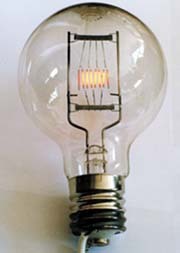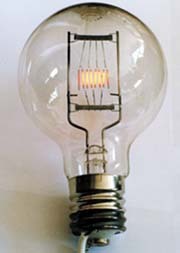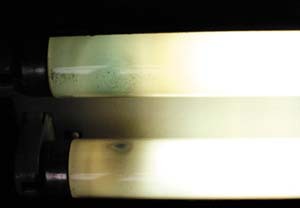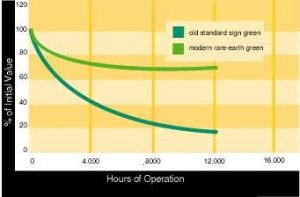Although some ancient historical texts indicate that the human lifetime is 70 years, the Greek term "methuselah," implies that the human lifespan can vary. Although tempting, I won’t focus on philosophical or moralistic definitions of life related to mankind.
Rather, this month, I’ll discuss different meanings of "lifetime" in relation to technical products, especially lamps. To enhance their knowledge, interested readers might wish to consult further articles pertaining to mathematics and statistical theory.
In response to rising, cutthroat competition in the electric-sign business, lamp manufacturers are promising longer "lifetimes" (according to many lamp salespeople, an LED has an average lifetime of more than 100,000 hours). Many clients, who aren’t familiar with lifetime terminology, might think that, if a 100,000-hour lamp fails after 95,000 hours, the manufacturer will replace the product. Unfortunately, this isn’t always the case.
Dead or alive?
For a single incandescent lamp, this question is easy to answer — either the lamp will operate once power is applied, or it will remain dark if the filament is blown. What’s more difficult to predict is when the filament will blow (under normal operating conditions).
If a manufacturer states, "Guaranteed lifetime is x amount of hours," and the lamp fails before this time has elapsed, the manufacturer must replace the lamp (correct operating conditions presumed) at no additional cost. You might ask, "Where’s the problem?" Problems arise if the manufacturer states anything different than a guaranteed lifetime for each single lamp. In contrast, manufacturers usually indicate an average lifetime for incandescent lamps.
Note: There are more reasons why an electric sign fails than just a simple lamp blowout. The combination of all probable failures makes total sign reliability (mathematically expressed as combined or system probabilities) a subject too complex for discussion in this column. Thus, I’ll focus on single part failure.
Average and probability
If a manufacturer states an average lifetime of 2,000 hours for a lamp, rarely will the company replace a product for free (even if a lamp burns out during its first operating hour). Why? This answer is determined by how the average was obtained and how certain the value is — in other words, statistics.
Here’s an example. A manufacturer produces two lamps and runs a test in which one lamp fails after 2,000 hours, and the other fails after 2,500 hours. Simply, the average value is 2,250 hours. The same result could be obtained if one lamp fails immediately, and the other operates 4,500 hours before failing.
An "average" lifetime has no meaning until a second number is known — the certainty or standard deviation of the average value. German mathematician Carl Friedrich Gauss (1777-1855) pioneered the mathematical evaluation of deviating test values and predicting a certainty for the average value. He developed the theory of standard distribution and its well-known bell curve.
Certainty depends on the number of tests conducted. Thus, if I perform 100 tests instead of two, and more than 50 fail after 2,200 hours of operation and before 2,300 hours of operation, I can assume that an average lifetime of 2,250 hours is reasonably accurate.
However, regardless of the number of tests, one lamp out of a million still may fail during the first five minutes of operation.
This information about multiple tests and average lifetime relates to a series product, where several equal items can be tested for a long time. However, this doesn’t relate to neon signmaking.
Neon signs are custom-made and typically require quick turnaround. As a result, signmakers can’t conduct multiple lifetime tests to achieve
an average lifetime. Assuming a lifetime of 30,000 hours, a 24/7 life test must run 3.42 years on average to determine a neon-sign failure. Now, how can a product — which can’t be tested in multiple units to determine its lifetime — be guaranteed at all? The answer is guesswork. However, mathematical methods can reduce the risk of this guesswork.
Estimating life
Probability theory enables us to predict lifetime. To test this theory, you must incorporate known parameters that influence the life of the device being tested (for example, a new lamp type). Tests conducted using similar lamps might determine that the device’s operating current, when increased by 20%, could reduce its life by 50%. Further, an overload of 40% will reduce a lamp’s lifetime to 20% of the original value.
Assuming a new lamp will behave similarly, a small-group test of these lamps (10 to 20 lamps), conducted at 40% overload conditions, will accelerate the test cycle. To this data (along with the given assumptions), many different theories can be applied to render a theoretical lifetime under normal operating conditions.
Details of this mathematical concept are complex, but I can provide a few simple explanations. The more experimental data you record, the more accurate your proposal will be. The more assumptions you make to obtain this data, the more correct the theoretical value will be (this value, however, will be less representative of real-life conditions).
In other words, long-term experiments under real-life conditions produce the most accurate results. Fast-forward aging tests, which don’t incorporate an abundance of guesswork, decrease the outcome’s predictability. Thus, beware of new products that are marketed as "long-lasting," yet weren’t tested for long-term reliability under real-life conditions.
The useful life
I’ve discussed lamp life that ends with a burnout or complete failure. But in reality, electric light sources degrade with operating time. In a standard lightbulb, the tungsten from the filament evaporates with time and creates a black deposit on the glass bulb, thus reducing the light output (Fig. 1).
Crystal deterioration of semiconductors in LEDs, and fluorescent phosphors in fluorescent lamps (Fig. 2) and some neon tubes, also decrease light output (Fig. 3). Of course, a lamp can operate up to the final burnout. But, at what light-level reduction is lamp operation still considered useful?
A light source’s acceptable light reduction depends on its application. Therefore, definitions pertaining to "useful lamp life" are very different, and exact conditions need to be considered when making comparisons.
Lifetime considerations for a custom-made product, like neon, should rely on your experience with similar objects/installations, which have proven their reliability. From 90 years of neon experience, it can be stated that a properly fabricated, correctly loaded and installed-to-code neon application will survive at least 30,000 hours — with 80,000 hours being no exception. And estimating an 11.4-year life (operating continually for 100,000 hours), for a product developed in the lab two weeks ago, is more risky than statistically being hit by lightning.



 Photo Gallery2 weeks ago
Photo Gallery2 weeks ago
 Paula Fargo1 week ago
Paula Fargo1 week ago
 Real Deal1 week ago
Real Deal1 week ago
 Photo Gallery1 week ago
Photo Gallery1 week ago
 Projects1 week ago
Projects1 week ago
 Women in Signs2 weeks ago
Women in Signs2 weeks ago
 Signs of the Times2 weeks ago
Signs of the Times2 weeks ago
 Business Management6 days ago
Business Management6 days ago












